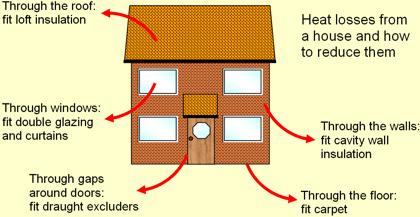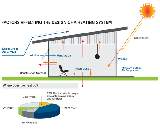
|
 |
If you are thinking about building a new house then it is important to know that simplicity in 'form' will save you heaps of cash in energy running cost.
How Does A Simple Form Save Me Money?
Well it's like this. The more surface area your building has the more heat it will lose.Example
If you had two buildings with the same area in floor space, one is a two storey design with only four external walls. The other a single storey with eight external walls. Even though the two storey building may have a little more wall area the single storey is more complex in design having more surface area as well as corners means it losses thermal heat at a greater rate and therefore is more energy demanding.
Remember this, architects, designers and builders generally deal with heat loss when the design is complete. You can always get better doors and windows, thicker insulation to cope with a complex design, but it cost more. A simple form means reduction in both build and running cost.
Can I Calculate The Heat Loss Myself?
Yes you can. If you wanted a precise reading then you would need to have a lot of information based upon temperature differences internally and externally (Heating Degree days). The 'Thermal Transmittance Coefficient' or "U" Value and the 'Thermal Resistance Coefficient' or "R" Value of all the material that you would be using in your build and furnishings, and a raft of other factors, which is quite a lot.So to have an approximate idea (a rule of thumb method) calculate the room volume in cubic meters, then divide by 20 to get the heat required in kilowatts. So a room that measures 10 meters in length, 5 meters in width, and 2 meters high will require approximately 5 kilowatts of heat. ((10x5x2)/20) = 5 kilowatts.
(Note: The temperature inside of an unheated building is usually around 2.78oC higher than the outside air temperature, so when the outside air temperature is at 15.6oC the inside temperature will be 18.3oC and this is close to the average internal design temperature. The 'Degree Day' is the difference between 15.6oC and the daily 'mean' outside temperature when it is below 15.6oC.
For example, if the mean outside temperature on a particular day was 8oC then the number of 'degree Days for that day would be; 15.6 - 8 = 7.6 Degree Days)
The Calculation For Underfloor Heating - Is It Different?
Yes. The heat loss calculations for underfloor heating is slightly different in that there is a 1oC reduction in internal air temperature to reflect the added value of radiant heat, however no reduction is made in bathroom areas. Undefloor heating creates weak convection currents this enables lower air change rates to be used in the heat loss calculations.Underfloor heating does not produce the same convective gradients of heat associated with natural and forced air convection systems as it warms you from feet up, where you like it the most. Who wants a hot head?
If you would like a free heat loss calculator - Click here
Heat Loss by Ventilation
All buildings need to be ventilated to remove moisture. However, air changes means thremal heat loss. Cold air is sucked into buildings by the warmer air inside. This process reduces the internal temperature.So to raise the temperature of 1 cubic meter of air through 1oC in 1 second will require approximately 1340 watts. If you use this air multiplying factor 0.33 you can work out the approximate ventilation heat loss yourself.
(The factor 0.33 is the product of the specific heat and density of air under typical conditions)
Example
Lets take a dining room which on average has 1.5 air (volume of air in room) changes per hour. 1.5 x 4 x 5 x 3 x 0.33 = 29.7 watts.
* When a mechanical extract ventilation is installed in a room it is possible for the minimum fan duty to exceed the minimum air change rate. In these cases it is advisable to allow for the increased air change in the thermal heat loss calculation for both the room and connecting room(s) from which that air will be drawn.
**When a shower or bath is fitted into a bedroom, or where an opening without a door exists between the bedroom and the en-suite area, then the air change rate should be increased to allow for the movement of air caused by the extractor fan.Heat Loss by Conduction
The "U" Value make it possible to calculate the amount of thermal heat which can be conducted through the various layers of materials in the building structure. It takes into consideration the thickness of structure and the resistance to heat flow, caused by the film of air on the surface of the structure.The "U" Value is the amount of thermal heat which will flow in 1 second through a particular piece of structure for every 1K (Kelvin degree) temperature difference. "U" = W/m2K
The amount of heat loss through a section of the structure such as a wall is obtained from;
area m2 x temp rise oC x "U" value W/m2K = Heat Loss(W) watts
Example
A room has an external wall 5m x 3m. it has a 280mm brick wall with an unventilated cavity, and it faces east. The "U" value is 1.8W/m2K. the temperature difference is from -1oC outside to 18oC inside. 18 - (-1) = 19. Area of wall is 5m x 3m = 15m2
15 x 19 x 1.8 = 513 watts
Well as I mentioned above there are a raft of factors and data that you would need to know to preform a precice thermal heat loss calculation. However, the rule of thumb method - volume devided by 20 will give you an approximate guide and that it is 'only a guide' and not an exact calculation of heat loss.
See also:

